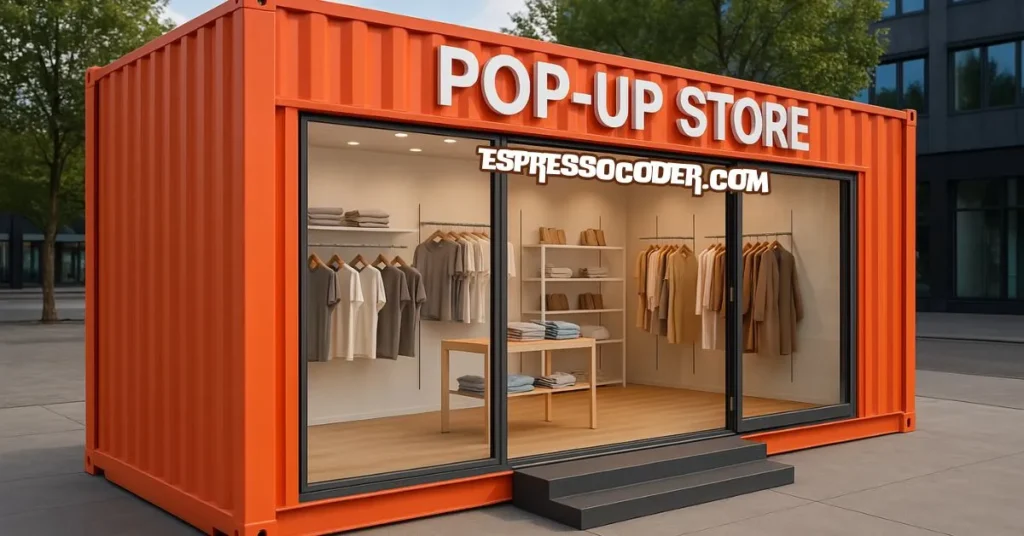Contents
Introduction to Shipping Container Pop-Up Stores
Repurposed shipping containers have emerged as a strong contender in the quest for unique and adaptive retail solutions. These adaptable hub spots have gained traction among entrepreneurs and established brands alike. Unlike the classic brick-and-mortar model, container pop-ups offer a fresh, versatile approach that aligns with consumers’ demand for immediacy and novelty.
As consumer trends lean more towards experiential shopping, shipping container pop-up stores cater to these demands by providing an innovative, unique, and temporary shopping experience. This trend is not just about aesthetics; it’s a strategic move for businesses looking to capture consumer attention and test new markets without hefty investments. The allure lies in the opportunity to create an engaging retail space that can be deployed quickly and shifted easily, resonating with the agile pace of today’s market dynamics.
Why Shipping Containers?
Originally crafted for the robust demands of global shipping, shipping containers have proven themselves formidable assets beyond their intended use. The logistics behind why shipping containers have found a place in retail are compelling. They offer the adaptability that traditional construction often lacks. A shipping container shop, for example, can be easily customized and relocated, providing retailers with a flexible, cost-effective solution for testing new markets or offering seasonal products. Their uniform size and durability make them ideal modular units for creating pop-up shops that can be as minimalistic or extravagant as necessary.
The cost factor cannot be overlooked. A shipping container can be significantly less expensive compared to developing a permanent structure, making it appealing for start-ups and multinational companies testing new locales. As noted by shipping container architecture trends, these structures have become architectural icons in their own right, providing a contemporary and often sustainable alternative to traditional retail spaces.
Benefits of Pop-Up Stores
The strategic benefits of shipping container pop-up stores extend far and wide. Flexibility is at the core of their design; they can be relocated, resized, and reconfigured with relative ease. This portable nature allows businesses to react swiftly to market changes, setting up shops in unconventional locations or tracking consumer trends and festivals without the limitations of permanence.
This transient model is financially advantageous. With lower upfront investment than fixed retail locations, brands can allocate more resources to inventory, marketing, and design, enhancing their ability to cultivate a dynamic consumer experience. Moreover, pop-ups offer a sandbox environment for brands to experiment with product lines and engage directly with customers, gathering real-time feedback and insights that can refine long-term strategies.
Design and Customization Options
Customizing a retail shipping container offers a world of possibilities. Entrepreneurs and designers are collaborating to transform these plain metal boxes into stunning commercial spaces. Shipping containers can be equipped with cutting-edge technology, decorated with brand-centric designs, and furnished with sustainable materials that enhance consumer interaction.
With thoughtful planning, a container can morph into a branded universe. Consider using innovative materials, lighting, and interactive elements to captivate and engage customers. Creative design strategies are crucial, as an aesthetically pleasing environment will drive foot traffic and elevate the customer experience.
Real-Life Success Stories
The impact of shipping container pop-up stores is best highlighted through the success stories of the businesses that utilize them. From fashion retailers to gourmet food sellers, these adaptable stores provide an opportunity to engage audiences differently. Brands have used containers to become more mobile, connecting with their market in diverse locations and fostering a sense of novelty and exclusivity.
Such setups have allowed businesses to engage with multiple demographics by moving to high-traffic areas or aligning with events or festivals. The flexibility and creative freedom in interior and exterior designs have enabled many brands to attract and retain customers by creating memorable experiences.
Sustainability and Environmental Impact
Beyond business benefits, the environmental advantages of shipping container pop-up stores are noteworthy. Repurposing an existing structure curbs waste associated with new constructions, reducing the overall carbon footprint. Such sustainable practices align well with contemporary consumer values, which increasingly prioritize environmental responsibility.
Transforming unused containers into retail spaces supports the broader trend of circular economy and resource efficiency. This sustainable aspect provides an additional narrative for brands to communicate, appealing to a growing base of eco-conscious consumers looking for brands that reflect their environmental values.
Getting Started with Your Own Pop-Up Store
Embarking on creating a shipping container pop-up store involves strategic planning and creativity. To begin, determine your target market and select a location that optimizes visibility and foot traffic. Navigating permits and zoning regulations is crucial, and once the logistics are in place, focus on the container’s design and ambiance to ensure customer attraction and retention.
Building a compelling experience within your pop-up store with engaging displays and interactive components can differentiate your brand from competitors. With thoughtful planning and execution, businesses can craft a unique shopping environment that seamlessly blends brand storytelling with product interaction.
Future Trends in Retail and Popup Solutions
As businesses continue to innovate, the future of retail points towards a heightened presence of container pop-up stores. Anticipated trends include a deeper integration of digital experiences, such as augmented reality and cashless systems, designed to streamline the shopping journey. These innovations will likely redefine how consumers engage with retail spaces.
In conclusion, the rise of shipping container pop-up stores represents a fusion of practicality and innovation. Their versatility and sustainability position them as key elements in the modern retail landscape, offering businesses new avenues to explore consumer engagement and brand development in an ever-evolving market.

